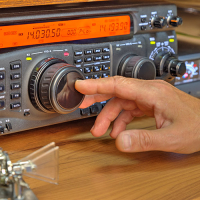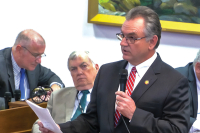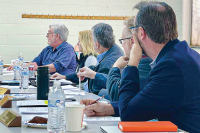Drug testing in Haywood County schools: do results justify cost?

Some surprising statistics regarding drug testing in Haywood County schools have raised questions about the policy’s cost and effectiveness.
Mark Sheppard from Academic Support Services reported to the board at its Aug. 8 meeting that out of a pool of 1,076 students this year, 255 students were tested — 24 percent of eligible students.
“Of those 255, 19 tested positive,” he said, noting that that figure represents just under 8 percent of students tested.
Random drug testing has been in place in Haywood County schools since 2006; according to board policy, any students who compete in interscholastic activities or park a car on campus are eligible for testing.
Over the past four years, the percentage of students testing positive — overwhelmingly for marijuana, but also for benzodiazepines like Valium and Xanax — has quadrupled.
“Three years ago, we were just under 2 percent, just under 4 percent the year after that, just under 6 percent last year, and this year, just under 8 percent,” he said.
Related Items
Sheppard did go on to present a caveat to the trend, opining that since the sample size of the testing was so small, just a few positives could skew results dramatically.
Drug testing in schools has been a controversial issue since the Supreme Court approved more invasive testing in a 2002 ruling.
The American Civil Liberties Union, however, says there is “no concrete evidence” random testing deters drug use among students, and a 2015 Washington Post article calls such testing costly and ineffective.
But the National Center for Education Evaluation and Regional Assistance continues to cite a 2006 study it commissioned that was conducted in seven states and included 4,600 students, stating that students who are “involved in extracurricular activities and subject to in-school drug testing reported less substance abuse than comparable students in high schools without” drug testing programs.
All sources seem to agree that testing does not address the root causes of drug use among students.
In Haywood County, those 255 tests cost taxpayers $7,315 last year, or more than $28 each — an eyebrow-raising figure for a school district that faced a $2.4 million budget deficit this past fall, closed Central Elementary School as a cost-cutting measure June 14 and sees teachers spend an average of $500 each year out of their own pockets on supplies their students can’t afford.
Board member Rhonda Cole Schandevel — who hopes to unseat State Rep. Michele Presnell, R-Burnsville, in November’s general election — said she supports the policy, even though there are no initial penalties for students who fail the tests.
“The research shows that it is productive, and until it proves otherwise, I am in favor of that,” she said. “Just the fact of letting their parents know, and letting them address that, I think it is our duty as a public school system to do that.”
Board Chairman Chuck Francis, who will serve another term as such if he can get past Craig Messer in November, also expressed his support for the policy.
“I feel it does deter drug use, because what it does is it keeps it in the family unit. It doesn’t become punitive until the third positive test. What happens then is there are possible suspensions, possible expulsions, other possible ramifications like not being allowed to participate in athletics and so on,” he said. “What the policy was originally based on is not knocking the child down, but to try to get information to the parents — identifying the child, and that you need to address this as a parent.”
The Centers for Disease Control and Prevention says that 18 percent of public schools nationwide have mandatory drug testing policies similar to Haywood County’s.
“If it helps just one kid to ‘just say no,’ it’s worth it,” Francis said.
There was no action item associated with Sheppard’s report, meaning the board did not vote on the issue or alter the current random drug testing policy in any way.









